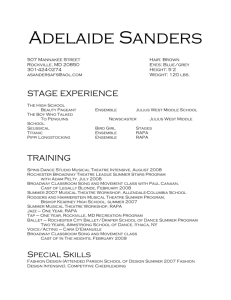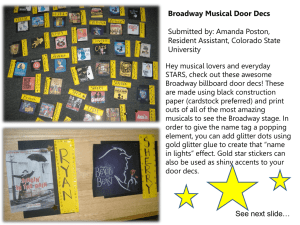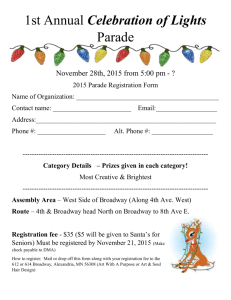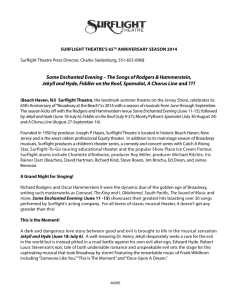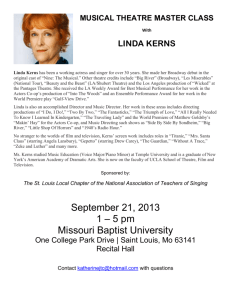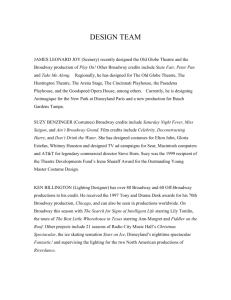Musical Theatre History - Queen Anne's County Public Schools
advertisement
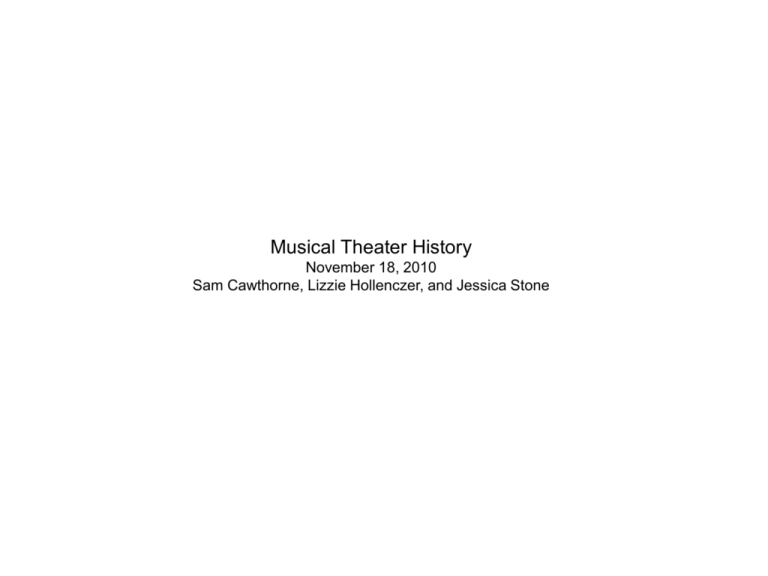
Musical Theater History November 18, 2010 Sam Cawthorne, Lizzie Hollenczer, and Jessica Stone Physical Theatre • • • • • • • • • • Over time, stages have improved for both the actors and the audience. At the end of the 19th century, a design called the box set was regularly used. The box set interior has three walls and sometimes a ceiling Also, the stage floor was beginning to level out, rather than raked back In the 20th century, staging was simplified to put more focus on the actors. Scene designers wanted to keep clutter off the stage and still keep the mood and setting of the play clear. They used abstract ways of doing this and others used more literal methods. Lights were placed in the auditorium to allow a natural look to the lighting of the actors and sets. Colored lights were formed by putting colored “gels” over the lights. In modern-day theatre, sets sometimes move themselves (do not require as much back-stage personnel), sets are designed to represent where the characters are rather than what they are feeling, and sets are much more advanced than earlier time periods. Timeline 1700’s: • 1st professional theatres formed in Philadelphia and Charlestown 1800’s: • Broadway was New York’s main thoroughfare; desirable location for all business, including theatres • Melodramas were very popular, as well as musical romances • French and Viennese Operetta 1850-1880 • Popular American forms of entertainment: circus acts, singers, dancers, chorus girls, and bawdy comics • Minstrels: American born from musical theatre beginning in the 1840’s • Minstrels were perfected to a third form and used in most shows • Vaudeville: a town that tried to bridge the gap dividing American audiences because life was hard there; tours lasted 40 weeks or more; pay for workers was bad - Other acts in the town included: mind readers, instrumentalists, escape artists, flash acts (anything showy), high divers, quick change people, strong men, and living statuaries - Shows ended because of the Great Depression • Burlesque: rich source of music and comedy; kept Americans laughing from the 1840’s-1960’s; though original is gone, it is legally still alive (“Saturday Night Live”) Timeline (continued) • • • • • • • • • • • • Gilbert and Sullivan: created 14 stage musicals, revolutionized theatre 1900-1910: London was the theatre capital of world; 33 legitimate Broadway shows; Broadway boasted about musicals 1910-1919: producers focused on exporting musicals from Europe 1920’s: bustle decade; 50 new musicals in one season; $3.50 per seat 1930’s: Vaudeville dies, fear for Broadway’s survival; ticket buyers scarce 1940’s: after great depression, producers focused on fun songs to give people escape from reality 1950’s: Broadway musicals became a major part of American pop culture; new musicals every season 1960’s: off Broadway was born; first off Broadway musical: “The Fantasticks” 1970’s: musicals thrived with energy; rock musicals were popular such as: “Hair”, “Godspell”, “The Me Nobody Knows”, and “Jesus Christ Superstar” 1980’s: first hit of 80’s was “42nd Street”; 80’s saw many new musicals and off Broadway shows; shows were flashy 1990’s: less than 5% of people were attending theatre; $60 per ticket 2000’s: No one in the Broadway community was sure about musical future; many new shows that are still running such as: Jersey Boys (2005), Tarzan (2006), and The Color Purple (2005) Gene Kelly • Born: August 23, 1912 • Died: February 2, 1996 • Born and raised in Pittsburgh, PA • Debut- in the chorus of “Leave it to Me” (1938) • Best known for his talents as a dancer • Some of his most prominent performances include: -“On the Town” (1949): starred with Frank Sinatra, Jules Munshin, Ann Miller, Vera-Ellen, and Betty Garret Gene Kelly (above) in the famous musical “Singin’ in the Rain” “I didn’t want to move or act like a rich man. I wanted to dance in a pair of jeans. I wanted to dance like the man in the streets.” –Gene Kelly - “An American in Paris” (1951): showed his dancing abilities the most - “Singin’ in the Rain” (1952): starred with Debbie Reynolds, Donald O’Conner, and Jean Hagen Matthew Broderick • • • • • • • • Has talents for both comedy and drama He became established in NYC theatre 1st big screen success was in “War Games” where he played a computer wiz caught up in a nuclear intrigue Involved in many Neil Simon productions, such as “Brighton Beach Memoirs” (1982-83), where he portrayed a character based on Simon as a young boy Simon provided him with many comic roles Dramatic skills were honed by a director named Horton Foote His debut role for live theatre was in Foote’s workshop production of “On Valentine’s Day”, where he performed with his late father James Broderick Best known for his role as Ferris Bueller in the teen comedy “Ferris Bueller’s Day Off” (1986) Ethel Merman Born: January 16, 1909 Died: February 15, 1984 • Most successful musical comedy performer of her generation • Daughter of Edward Zimmermanbookkeeper and amateur pianist and Agnes Gardner Zimmerman • Known for loud, clear voice, and great enunciation • Favorite of songwriters, such as George and Ira Gershwin, Cole Porter, and Irving Berlin • Introduced their most popular songs: “I got Rhythm”, “You’re the Top”, and “There’s no Business Like Show Business” • Merman also performed in the musical “Anything Goes” (1936) Ethel Merman (continued) • Starring role as Rose in Jule Styne’s and Stephen Sondheim’s “Gypsy” • Primary achievement was in her 13 roles on Broadway between 1930 and 1959 • Began singing as a child in public and entertained in WWI camps • Shortened her last name to Merman and performed at the Palace Theatre in NYC after graduating high school • Performed on first legitimate stage in Gershwin’s Musical “Girl Crazy” (NYC- Oct. 14, 1930) • “Girl Crazy” played 272 performances • First appearance in feature film was in “Follow the Leader” (December, 1930) 1. Song: “There’s No Business Like Show Business” 2. Song: “Everything’s Coming up Roses” Julie Andrews • • • • • • • • • Born: October 1, 1935 Known for impressive vocal range and perfect pitch Starred in “My Fair Lady” (1964), which was her most difficult role. Born Julia Elizabeth Wells in Walton-on-Thames, England Mother- pianist Birth parents divorced when she was young Mom remarried to Edward Andrews Took her step-father’s last name and family traveled around Europe Parents performed for a living and Julie, as she was often nicknamed, began singing with her father in air-raid shelters during WWII when she was only 8 years old Julie Andrews (continued) • • • • • • Her vocal chords, by then, had already fully matured, and her mother enrolled her in singing lessons with Madame Stiles-Allen At 12 years old, she was performing at the same venues as her mother and step-father Debut as a singer: “Starlight Roof” at Hippodrome Theatre in London’s West End Noticed by director Vida Hope, who brought Julie to Broadway in the U.S. Julie played Polly Brown in Hope’s musical “The Boy Friend” She also starred in “The Sound of Music” (1965) and “Mary Poppins” (1964) 1. “Mary Poppins (1964)” 2. “The Sound of Music” (1965) Choreographers, Directors, and Producers Mel Brooks • Born: June 28, 1926 • Brooks went from a TV writer to a series creator to a movie producer • He formed the company Brooks Film, Ltd. • He helped turn his Oscar-winning film, “The Producers”, into a Broadway musical • Also directed the comedy film “History of the World Part I” • “High Anxiety” (1977) was his last largely acceptable film and after that relevance, quality, and freshness had severely declined Mel Brooks: “History of the World Part I” Tommy Tune • • • • • • Born: February 28, 1939 Tune is an actor, dancer, choreographer, and director He majored in performing arts at the University of Texas His “big break” came when he was a performer in “Seesaw” He became the successor to people like Bob Fosse, Jerome Robbins, Gower Champion, and Michael Bennet Earned 9 Tony Awards as well as an induction into the New York Theatre Hall of Fame in 1991 Susan Stroman • Born: October 17, 1954 • Choreographer • She came onto the scene when she received 4 Tony nominations for her work in “Contact” and “The Music Man” • She helped choreograph and direct “The Producers”, which won 12 Tony Awards that included choreography and directing • Stroman had many failed attempts on Broadway before she really began to shine Jerome Robbins • Born: October 11, 1918• Died: July 29, 1998 • Robbins was a director, choreographer, and dancer. • He began his career with Ballet Theatre in New York • From 1944-1967, he devoted his all his time and energy into Ballet. • He returned to Broadway for a brief period in 1989 • Directed “West Side Story” (1961) which starred Natalie Wood and Richard Beymer Harold Prince • Born: January 30, 1928 • He is a distinguished director and producer • Career spans over 4 decades • Presented his first musical “The Pajama Game” in 1954 • He has 20 Tony Awards, which is more than any other choreographer, producer, or director Composers, lyricists, and writers Stephen Sondheim • • • • • • Born: March 22, 1930 Studied piano for 2 years Grew up in West Side of Manhattan Wrote lyrics for: - “West Side Story” - “Gypsy” (but was fired because Ethel Merman wanted a composer with a track record) - “Anyone Can Whistle” (1964) - “A Little Night Music” (1973) - “Sweeny Todd” (1979) - “Merrily We Roll Along” (1981) - “Into the Woods” (1987) He was greatly influenced by Oscar Hammerstein, who helped to acquire a love of musical theatre Won 26 Awards during his career as a composer and lyric writer Oscar Hammerstein II • • • • • • • • • • Born: July 12, 1895 Died: August 23, 1960 Born in New York City into a theatrical family Grandfather, Oscar I, was a showman and opera impressano Father, William, was the manager of Victoria, one of the most famous theatres of its day Uncle, Arthur, was a well known producer Originally went to Columbia University to study law, but ended up taking up his theatre career when he was 19 by joining Columbia University players as a performer. He wrote the music for “Oklahoma”, which was a hit when it opened on Broadway on March 31, 1943. On August 23, 1960, Oscar died of stomach cancer The lights on Broadway were extinguished to honor Oscar; “the man who owned Broadway” Richard Rodgers • • • • • • • • Born: June 25, 1902 Died: December 30, 1979 Demonstrated musical talent at early age. 4 years old: began to pick out tunes from “The Merry Window” 10 years old: wrote his first song “My Auto Show Girl” Went to Columbia College, and we honored as the first freshman to write the score for the Varsity show had a second successful partnership with Oscar Hammerstein They worked together until Oscar died in 1960. Lorenz Hart • • • • • • • • Born: May 2, 1895 Died: November 22, 1943 Musical comedy lyricist Born in NYC Eldest of 3 Spent two years (1914-1916) at the school of Journalism of Columbia University. At one of the opening nights of “Pal Joey” (composed by both Hart and Rodgers), Hart was found ill in a hotel room and was rushed to New York City hospital, where he died 3 days later of pneumonia He was buried in Mount Zion Cemetery in Queens Rodgers and Hart • Rodgers met Hart while in school and they became partners for the next 20 years • Rodgers and Hart had a very successful partnership that started in 1918. • Unlikely partners because they were very different people • They contributed to the musical “Poor Little Ritz Girl” (1920) • They became successful together on Broadway by 1925 • Some of their hits include: - “My Funny Valentine” - “The Most Beautiful Girl in the World” - “Manhattan” - “Bewitched, Bothered, - “Thou Swell” and Bewildered” - “Johnny One Note” - “Blue Moon” - “The Lady is a Tramp” Andrew Lloyd Webber • • • • • • • • • • • Born: March 22, 1948 Showed musical talent at an early age Composed a short musical for his parents when he was a kid His first musical was “Joseph and the Amazing Technicolor Dreamcoat”, which he wrote in 1967 with Tim Rice (lyrics writer) He also did “Jesus Christ Superstar” with Tim Rice. There were several concert tours of the show and a film version too. Composed some of the most successful musicals in the last quarter of the 20 th century His most famous works include: - “Joseph and the Amazing Technicolor Dreamcoat” (1967) - “Jesus Christ Superstar” (1971) - “Evita” (1974) - “Cats” (1981) - “The Phantom of the Opera” (1986) “Evita” tells the story of a girl named Eva Peron. The show received many Tony Awards, one of which was for best actress (Patti LuPone) The movie version of “Evita” starred Madonna and Antonio Banderas. A new song was added to the score (“You Must Love Me”) and won its composer an Academy Award Designers and Theatre Circle Boris Aronson • • • • • • • • • • • Born: October 15, 1898 Died: November 16, 1980 Kenneth MacGowan referred to his work as a designer as futuristic. He was born in Kiev, UK in 1898 He studied art and stage design with a man named Alexander Exter. Boris said that it is necessary to examine the rhythm of a dancer and then work on the scenic construction. First major success was “The Tenth Commandment” (1926) Reputation improved when his set models were put on display in New York in 1927 Began working in New York by 1932 He designed sets for “Fiddler on the Roof” (1964), Follies (1970’s), and “A little Night Music” (1970’s) Last set design was in 1976 for “The Nutcracker”; won 8 Tony Awards and remained sculptor and painter until death Al Hirschfeld • Born: June 21, 1903 • Died: January 20, 2003 • Born in St. Louis and moved to NYC when he was 12 • Dropped out of school at 16 to earn a living • In 1924, he moved to Europe to work and study • In a visit back to NYC, he sketched a picture of a French actress named Sacha Guttry and showed it to his friend, who published it in THE NEW YORK HEROLD TRIBUNE and his career started • Pictured to the right are of some of his works THE END! We hope you enjoyed the show. Thanks for watching. Bibliography Cites Used: • "Broadway: The American Musical." Broadway: The American Musical. Educational Broadcasting Corporation, 2004. Web. 17 Nov. 2010. <http://www.pbs.org/ wnet/broadway/musicals/index.html>. • • "Essay: 19th Century American Theater." Digital Collections. University of Washington Library, n.d. Web. 19 Nov. 2010. <http://content.lib.washington.edu/19thcenturyactorsweb/essay.html>. "design reference." Reference.com. N.p., n.d. Web. 16 Nov. 2010. <http://www.reference.com/browse/design>.
